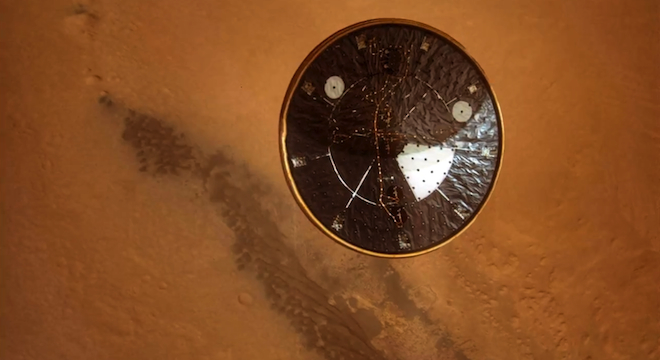The Mars Curiosity Rover’s nail-biting plunge to the surface of the Red Planet on August 6 can now be seen — from the perspective of the rover itself — in ultra high-definition video.
Independent video producer Bard Canning spent four weeks painstakingly reprocessing imagery released earlier by NASA showing the rover’s near-perfect descent as captured by its onboard Mars Descent Imager (MARDI), a downward facing camera.
The original imagery, 297 frames, was compiled by NASA into a video that shows the rover’s final two-and-a-half minutes of a 14-minute, hair-raising descent that involved an abrupt 14,000-mile-per-hour to zero slowdown. The rover began capturing the imagery just before it ejected its heat shield, which can be seen in the first few seconds of the video.
Canning used a video processing technique known as motion-flow interpolation, which involves creating new frames to fit in between existing frames, increasing the overall frame rate from the original, which was just 4-frames-per-second, and making the video appear more fluid at 30 frames-per-second. He also enhanced the color and the detail of the imagery and re-rendered it at “enterprise-quality 1080p, 50,000 kbps (instead of the usual ~1000kbps).”
“I manually added thousands of motion-tracking and adjustment points,” Canning wrote of his process on Reddit, “I had to go the laborious manual route because the frame-rate is too low causing the footage to jerk around too quickly for automated motion tracking to handle it.”
Check out the awe-inspiring results of his labor of love below:
“I was motivated to create this video from the first moment that I saw the original four frames-per-second footage,” Canning wrote to TPM in a Reddit message. “I could visualize exactly what steps would need to be taken to make it as close as possible to smooth HD video.”
Still, Canning admits that the video, while strikingly vivid and seemingly realistic, is not a precise view of what it would look and sound like to land on Mars.
“I believe that my video is more accurate in some regards and less in others,” Canning wrote, saying he sacrificed accuracy in color tone and through creating the intermediate frames.
Check out a comparison video of the original high-def, low-frame rate NASA video he started with, playing side-by-side to his enhanced “Ultra HD” version:
“My aim with this video was to bring the wonder of the Mars Science Laboratory mission to a wider audience,” Canning explained. “To this end, I had to make the video a little more ‘Hollywood’ than its previous incarnations. I expected some backlash for this, but as you can see, the response has been overwhelmingly positive.”
Indeed, in the 24 hours since his video has been posted on YouTube, it’s received over 300,000 views and over 11,000 “Likes,” (as well as only 111 dislikes).
Canning said he contacted NASA about the video, and that several people involved with the mission have gotten back to him, one who even requested to use it in NASA marketing material.
Canning also told TPM that he learned his incredible video editing skills through his studies at Australia’s National Institute of Dramatic Arts (NIDA), where he earned a bachelor’s degree in performing arts. He also said he’s taken “advanced training short-courses in these fields.”
“I have a passion for the convergence of science and media,” Canning told TPM. “In an age when ignorance and superstition are in some cases gaining ground over science and progress we must fight back with a narrative about science which every person on earth can relate to – which engages people’s hearts along with their minds.”
(H/T: io9)






